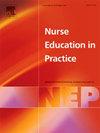教学护理过程中的积极方法:范围审查
IF 3.3
3区 医学
Q1 NURSING
引用次数: 0
摘要
目的探讨积极方法在护理教育中的应用,以教授护理过程。护理过程是临床推理、指导护理诊断和护理计划、执行和评估的系统方法。它的教学需要让学生积极学习的策略,以促进循证实践。根据乔安娜布里格斯研究所证据合成手册进行设计范围审查。方法综述包括确定综述问题、建立合格标准、设计检索策略、筛选和选择证据、提取数据、分析结果和展示结果七个步骤。检索于2023年7月进行,并于2024年2月在以下数据库进行更新:护理和相关健康文献累积索引、拉丁美洲和加勒比健康科学文献、摘录医学数据库、医学文献分析和检索系统在线、Scopus、Web of Science和谷歌Scholar。在PCC框架的指导下,该综述针对研究生和本科生护理学生(人口),护理过程(概念)和主动教学方法(背景)。结果101项纳入的研究提出了临床模拟、基于案例的学习、基于网络的学习、基于问题的学习、概念映射、虚拟模拟、电子记录系统、临床实践和实验室活动等关键的积极策略。护理评估是最常教授的步骤,其次是诊断、干预、评估和结果。结论积极方法对培养批判性思维、临床推理和判断能力有积极影响。在本科护理课程中,将这些策略与传统方法相结合,可以提高理论知识在临床实践中的应用。本文章由计算机程序翻译,如有差异,请以英文原文为准。
Active methodologies in teaching the nursing process: Scoping review
Aim
To map the use of active methodologies in nursing education for teaching the nursing process.
Background
The nursing process is a systematic approach essential for clinical reasoning, guiding nursing diagnoses and care planning, execution and evaluation. Its teaching requires strategies that engage students in active learning to foster evidence-based practice.
Design
Scoping review performed according to the Joanna Briggs Institute Manual for Evidence Synthesis.
Methods
The review involved seven steps: defining review questions, establishing eligibility criteria, designing search strategies, screening and selecting evidence, extracting data, analyzing results and presenting findings. Searches were conducted in July 2023 and updated in February 2024 on the databases Cumulative Index to Nursing and Allied Health Literature, Latin American and Caribbean Literature on Health Sciences, Excerpta Medica dataBASE, Medical Literature Analysis and Retrieval System Online, Scopus, Web of Science and Google Scholar. The review targeted graduate and undergraduate nursing students (Population), the nursing process (Concept) and active teaching methodologies (Context), guided by the PCC framework.
Results
The 101 included studies present key active strategies such as clinical simulation, case-based learning, web-based learning, problem-based learning, concept mapping, virtual simulation, electronic record systems, clinical practice and laboratory activities. Nursing assessment was the most frequently taught step, followed by diagnosis, interventions, evaluation and outcomes.
Conclusion
Active methodologies consistently demonstrated positive impacts on critical competencies, fostering critical thinking, clinical reasoning and judgment. Integrating these strategies with traditional approaches in undergraduate nursing curricula enhances the application of theoretical knowledge in clinical practice.
求助全文
通过发布文献求助,成功后即可免费获取论文全文。
去求助
来源期刊

Nurse Education in Practice
NURSING-
CiteScore
5.40
自引率
9.40%
发文量
180
审稿时长
51 days
期刊介绍:
Nurse Education in Practice enables lecturers and practitioners to both share and disseminate evidence that demonstrates the actual practice of education as it is experienced in the realities of their respective work environments. It is supportive of new authors and will be at the forefront in publishing individual and collaborative papers that demonstrate the link between education and practice.
 求助内容:
求助内容: 应助结果提醒方式:
应助结果提醒方式:


